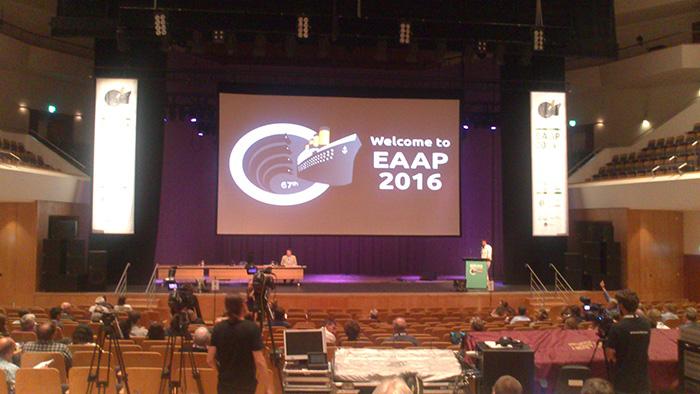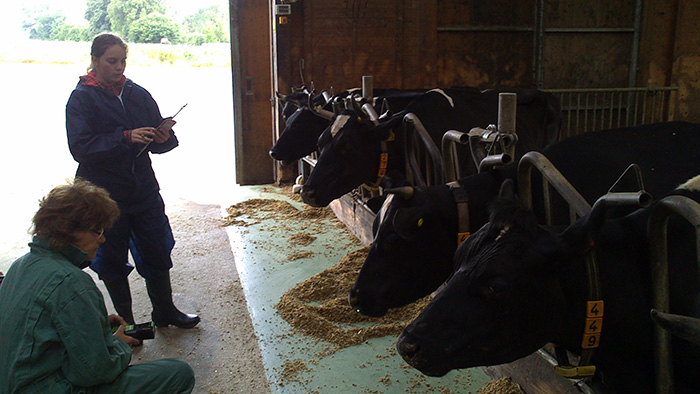2-Org-Cows: Reformulation of breeding goals
Conventional breeding and selection strategies of dairy cows generated a cow type that does not match the organic and low-input production criteria. Therefore, the 2-Org-Cows project focusses on the reformulation of existing dairy cattle breeding goals. Furthermore, the project addresses the use of local dual-purpose cattle that historically emphasized functionality, robustness and longevity.

A reformulation of breeding goals in the area of organic dairy production is crucial as breeding values of bulls may be re-ranked, depending on production system or region. Highly ranked bulls for conventional dairy production systems may not be the best choice for organic dairy or intensive grassland production systems. Owing to circumstances, robust dual-purpose dairy cows are better suited for extensive systems than modern high milk yielding breeds, often found in conventional systems and kept in confined barns all year.
Differences in management, feeding and medication between systems can possibly lead to so-called genotype by environment (GxE) interactions. Hence, an animal’s superiority in environment A, but a re-ranking in environment B, indicates how varying environments do not equally affect the performances of distinct genotypes. Consequently, specific breeding programs should be designed for different regions and production systems.
Results of GxE interaction presented
Some results of GxE interaction studies already revealed that especially for functional traits with low heritabilities, such as fat to protein ratio (indicator trait for metabolic stability) or somatic cell score (indicator trait for udder health), the choice of cattle breed for a certain production system is crucial. 2-Org-Cows members presented first results at the international EAAP (European Federation of Animal Science) conference in Belfast.
The session dedicated to GxE interaction regarding the ‘adaptation of dual purpose cattle to harsh environments’ stimulated intensive discussions. At the Interbull (International Bull Evaluation Service) conference in Puerto Vara (Chile), the French partner, Sophie Mattalia, presented first results on genetic evaluation of carcass traits in French dairy cattle. She compared dual-purpose breeds (Montbeliarde, Normande) with beef breeds regarding their ability to produce veal calves including the meat traits: carcass weight, age at slaughter and carcass conformation.

2-Org-Cows members presented first results at the international EAAP (European Federation of Animal Science) conference in Belfast 2016.
Trait recordings of local dual purpose cattle
The 2-Org-Cows project is evaluating novel functional traits and associated environmental descriptors (fodder quality, temperature, humidity, etc.). Thus, possibilities should be improved to observe a cow’s welfare status via Locomotion Score, Body Condition Score, Hygiene Score or the recording of health traits (clinical mastitis, retained placenta, milk fever, ketosis, claw lesions). In order to gather behaviour data, all our animals were equipped with a special sensor ear tag that measures the animal’s actions constantly and differentiates between rumination, feeding, walking and lying periods.
Combining these descriptors is a prerequisite for the implementation of organic breeding strategies of local dual-purpose cattle, and for preventive livestock health management. In consequence, the overall objective addresses both adaptation of the dual-purpose cow to pasture-based systems, and vice versa adaptation (improvement) of the system for improving functional (health) traits. The topic of dual-purpose cattle husbandry in pasture-based systems is viewed from diverse angles such as animal welfare, economic realization and feasibility and consumer-driven demands.
International exchange for young researchers
Project partners include PhD, Master and Bachelor students in their work and encourage student exchanges to other research facilities. Max Wefers, a student from Kassel University, studied the grazing behaviour of the endangered German dual-purpose black and white cattle breed with regard to pasture quality and sword growth. He analysed grazing behavior of 26 animals and depicted average bite frequencies between 45 and 80 bites per minute with significant fixed effects of grazing speed, preference of grass, legumes or herbs, feed intake inside the barn before pasture access, temperature, sword height, dry matter and percent of legumes at pasture. The size of bites greatly depended on pasture sword height.
Two master students from the Netherlands, Stijn van de Goor and Gerdine Kaptijn, examined calculation methods for net grassland production under different grassland utilization systems and evaluated the performance of dual-purpose cows in European pasture-based systems. A fourth master student from the Netherlands, Francisca Scholl, spent a week in Germany at Kassel University, where she learned how to score functional traits at the research Farm Frankenhausen. Her aim is to score Dutch dairy cattle herds as well as visiting other contract/research herds from other project partners to gather international data material on animal health and functional traits (Locomotion Score, Body Condition Score and Hygiene Score).

Francisca Scholl (right), a master student from the Netherlands, learns how to score functional traits at the research Farm Frankenhausen.
Contact
Maria Jaeger: maria.jaeger@agrar.uni-giessen.de
Project-Coordinator Sven Koenig: sven.koenig@agrar.uni-giessen.de